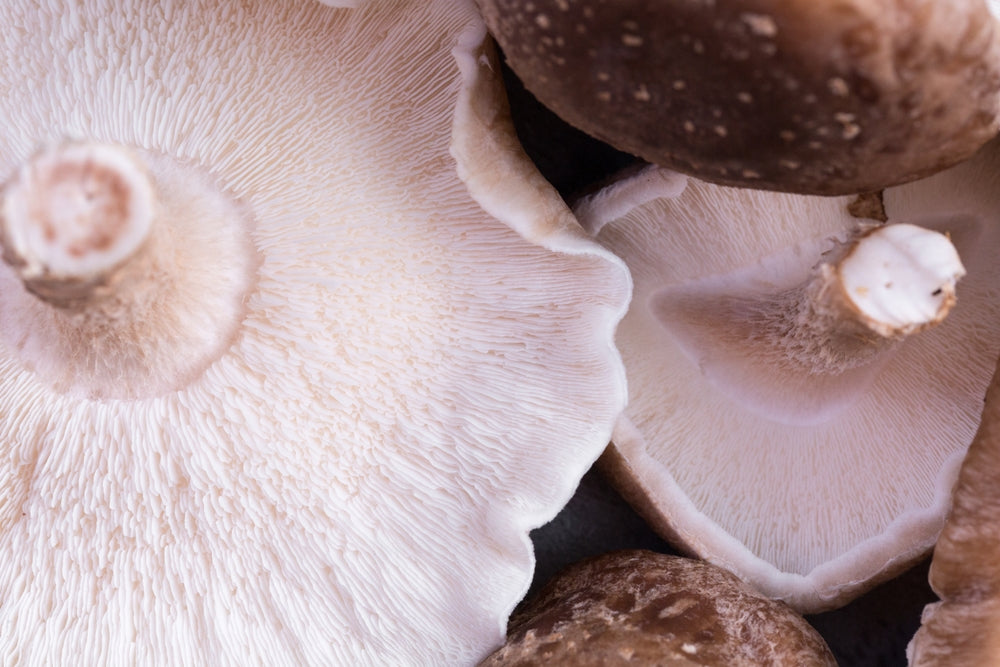Mushrooms have played a significant role in human civilization for thousands of years, with references to them found in ancient literature from the beginning of recorded history. Although the therapeutic benefits of mushrooms were recognized by ancient Egyptian and Chinese civilizations, the fungi had a bad reputation in Europe during the medieval and middle ages.
Many people viewed mushrooms with fear and associated them with witchcraft, believing they were poisonous and dangerous to consume.1 However, as more people learned about mushrooms, their acceptance spread throughout Europe. This trend increased in the seventeenth century as mushroom cultivation techniques became more advanced and the use of mushrooms in cooking became more widespread.
Mushrooms play an important role in the environment by decomposing organic matter, recycling nutrients, aerating soils, increasing the moisture-holding capacity of soils, and helping to reduce atmospheric carbon dioxide levels with long-term sequestration of carbon in the soil. Mushrooms are commonly associated with the button mushroom's classic cap and stem structure (Agaricus bisporus). The agarics are by far the most familiar group of fleshy fungi.2 However, mushrooms come in diverse shapes and sizes, including morels, chanterelles, coral fungi, and puffballs.
As a basic illustration, the most well-known shape of a mushroom has distinct parts such as the fruiting body with a round cap (pileus) that grows above ground, gills that release reproductive spores located under the cap, and a stem (or stipe). A root-like structure known as mycelium grows beneath the ground.
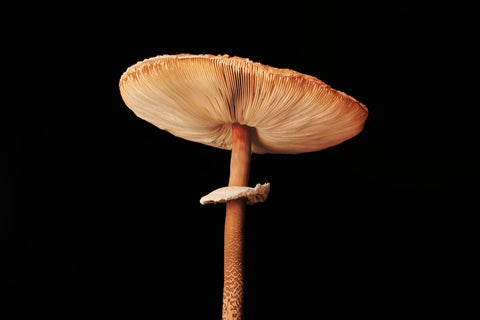
Mushrooms, unlike plants, lack chlorophyll and are unable to synthesize their food by photosynthesis. Instead, they obtain their nutrients from decomposing organic matter in the soil. Due to their unique ability to decompose cellulose and lignin, vital components of wood and other plant material, fungi play an important role in breaking down plant debris.3
Mycelium is made up of thin, cotton-like threads called hyphae, which secrete enzymes that break down organic matter into simpler compounds that the fungus can absorb. The mycelium's delicate structure acts as a conduit for nutrients, drawing them from faraway sources to fuel the rapid growth of mushrooms. These structures exhibit constant expansion, capable of traveling across landscapes at a rate of several inches per day, weaving an intricate network over the terrain.4
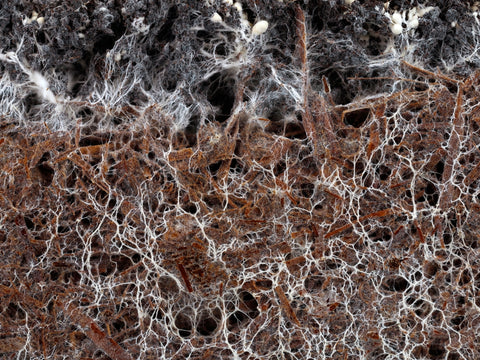
Functional Mushrooms Explained
The term "functional mushrooms" refers to mushrooms that are both edible and possess medicinal properties. Many functional mushroom species have a long history of therapeutic use in traditional medical systems such as Chinese medicine. However, it wasn't until the mid-to-late 19th century that scientific research on mushrooms gained traction.4
Early studies on mushrooms focused on identifying and describing their physical characteristics. This is exemplified by the research conducted by the resident botanist John L. E. W. Shecut in his work on Flora Carolinaeensis in 1806.5 And it wasn’t long before researchers turned their attention towards investigating the chemistry and pharmacology of mushroom compounds such as beta glucans, terpenoids, polysaccharides, polyphenols, carotenoids, and their many health-supporting benefits.‡
Functional mushroom species, such as Lion’s Mane, Turkey Tail, Shiitake, Reishi, Maitake, and Cordyceps contain these potent immune-modulating and health-promoting natural, organic compounds.‡ As a result, there is a growing interest among researchers and in modern medicine on investigating the potential medicinal uses of functional mushrooms and the bioactive compounds that they contain.
The Health-Supportive Benefits of Functional Mushrooms
There has been a surge of interest in functional mushrooms as a natural way to support overall health and wellness in recent years. Several functional mushroom species have gained more attention for their antioxidant and immune-modulating properties.‡
Om Mushroom Superfood grows 10 mushroom species, including Lion’s Mane, Reishi, Cordyceps, Chaga, Turkey Tail, King Trumpet, Antrodia, Shiitake, Maitake, and Himematsutake (also known as the Royal Sun Agaricus). These functional mushroom species are available in various formats, including powders, capsules, coffee products, and gummies, and can be used to support several different health goals.‡
Lion’s Mane
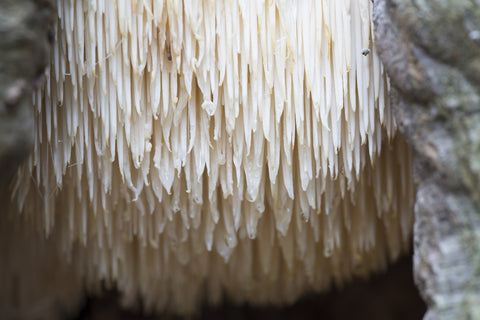
Lion's Mane (Hericium erinaceus) is a well-known culinary and functional mushroom with an aesthetically pleasing appearance similar to that of a lion’s mane or a sea anemone. This mushroom commonly grows in temperate forests on the hardwood surfaces of sycamore, oak, birch, and walnut trees in Asia, Europe, and North America generally feeding on dead trees but sometimes living as a parasite on living trees. Its long, hair-like spines will emerge from the tree when it reaches the reproductive stage. These edible mushrooms have a mild, slightly sweet flavor and texture that is similar to shellfish. They are a source of immunomodulating beta glucan polysaccharides and are known for their ability to support cognitive function and nerve regeneration.‡ Hericenone compounds in the fruiting bodies and erinacine compounds in the mycelium are thought to be the compounds primarily responsible for the effects on cognition and nerve health.
Reishi
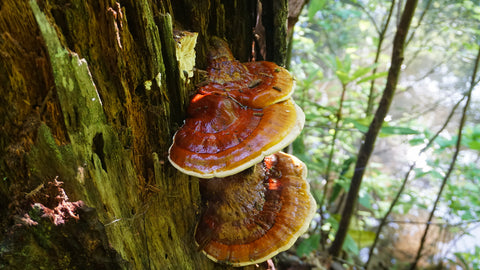
Reishi (Ganoderma lucidum), also known as the “mushroom of immortality,” grows on the stumps or logs of deciduous trees such as oak, plum, maple, and elm throughout the world, in temperate, subtropical, and tropical environments. Its high-luster fruiting body may be shaped like a fan or have antler-like shapes. Reishi can be reddish brown, purple, white, yellow, blue, or black in color. This mushroom species contains a variety of bioactive compounds such as triterpenes, antioxidants, polysaccharides, and beta-glucans and is considered to be an adaptogen that supports stress relief and that promotes healthy aging and longevity.‡
Cordyceps
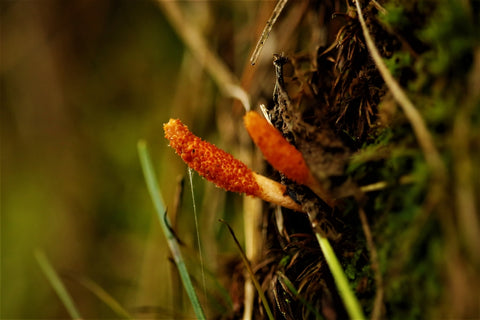
Cordyceps (Cordyceps sinensis or Cordyceps militaris) are a species of parasitic mushroom with significant functional qualities. In the wild, these mushrooms grow as parasites on insects, and other Arthropods. Tibetans have used Cordyceps, also known as “yartsa gunbu,” for at least two millennia as a natural remedy to restore energy levels. It has a slightly sweet and earthy flavor when used as a culinary ingredient. This mushroom is known to have significant antioxidant and immune-modulating properties.‡
Chaga

Chaga (Inonotus obliquus), also known as “the king of the medicinal mushrooms,” grows on white and yellow birch trees in cold climates such as northern Canada, Alaska, and Siberia. Chaga is a polypore fungus characterized by having numerous pores instead of a typical laminar gill structure. The mycelium of this species forms a sclerotium, also known as a sterile conk; a hard, blackish mass that protrudes from the bark of living trees where the tree has been wounded. The sterile conks have a hard, black, and crusty exterior that looks like burnt charcoal, while the inside is a rusty-brown color. Approximately 90% of the conks consists of the woody material that is the tree’s reaction to the infection and 10% consists of mycelium and contains abetulinic acid and melanin. Wildcrafted Chaga has an earthy, bitter flavor. Cultivated Chaga mycelium has a milder, less bitter, nutty flavor. Chaga mushroom mycelium contains significant amounts of antioxidants and is used to support the immune system and treat a variety of health concerns.‡
Turkey Tail
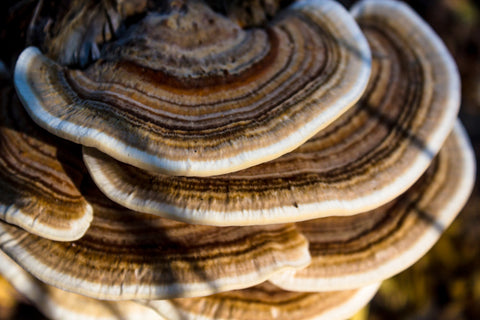
Turkey Tail mushroom (Trametes versicolor) is a fungus that typically grows on decomposing trees in forests across North America, Europe, and Asia, deriving nutrients from decaying wood. In doing so, they help recycle this organic matter and clear the forest floor, promoting new growth. Turkey Tail is being used industrially in “mycoremediation” processes to detoxify waste streams from industries such as textile dying and wood pulping. Their name is inspired by its fan-like shape and multicolored bands of brown, orange, and green, which resemble a turkey's feathers. With a bitter taste and chewy texture, Turkey Tail mushrooms are typically prepared in the form of soups, teas or broths. They are well-regarded for their immune-boosting capabilities, support of liver function and detoxification processes, and their ability to support digestive health.‡
King Trumpet
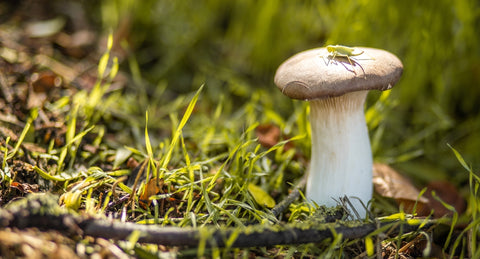
King Trumpet mushrooms (Pleurotus eryngii) have caps that can reach up to eight inches long. Also referred to as “king oyster mushrooms,” these fungi originated from the Mediterranean regions of Europe but are now cultivated globally. Due to its thick flesh, delicious taste, and medicinal properties, the King Trumpet mushroom is regarded as one of the most valuable edible mushroom species in China and other Asian countries.8 Their firm and chewy texture and delicate nutty taste make them highly sought after for use in many cuisines. They are high in ergothioneine, a unique amino acid compound with strong antioxidant properties. This mushroom has been shown to support bone health and to help with cholesterol management.‡
Antrodia
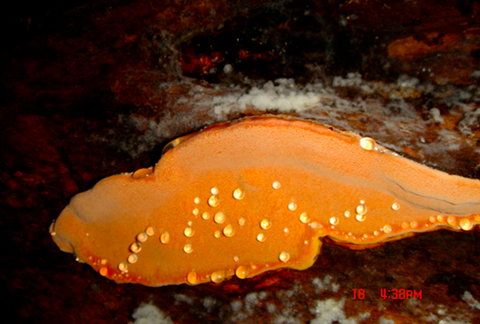
Antrodia mushrooms (Antrodia camphorata, or Antrodia cinnamomea), is a rare, parasitic fungus that lives in Taiwan’s forests inside the inner cavity of the Cinnamomum kanehirai tree. Significant conservation efforts are currently underway to protect their natural habitat and promote sustainable harvesting practices. Antrodia mushrooms have a bitter flavor and a woody aroma. These functional mushrooms contain several bioactive compounds that are that have been shown to have potent antioxidant properties and the ability to support liver function.‡
Shiitake
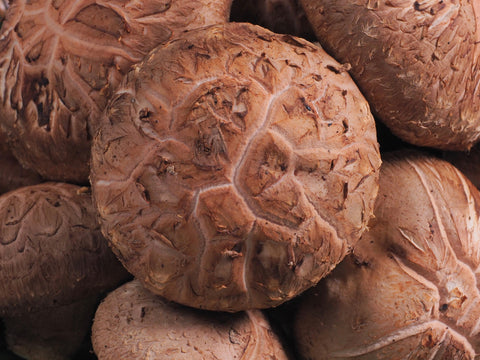
The Shiitake mushroom (Lentinus edodes) was most likely the first mushroom that humans cultivated.2This mushroom, which is native to Japan, is grown worldwide and commonly used in a variety of recipes. It grows on the hardwood surfaces of oak, maple, and ironwood trees and can range in color from light to dark brown. This useful mushroom has an earthy, smoky flavor and a soft, meaty texture. It is high in protein, fiber, vitamins, and minerals, is rich in Lentinan, a beta glucan polysaccharide, and has powerful therapeutic qualities that support the liver, cardiovascular system, and immune system.‡
Maitake
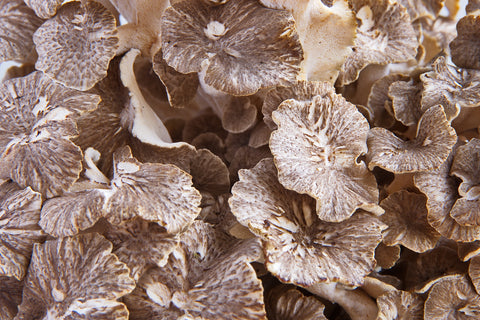
Maitake mushrooms (Grifola frondosa), also called “hen of the woods” and the “dancing mushroom,” are highly valued for their large size, rich, woodsy flavor, and meaty texture. They are native to Japan but can also be found in other parts of the world growing on oak and other hardwood tree species. They are difficult to locate in the wild and can be commercially cultivated and grown indoors. Maitake mushrooms are known for their immune-boosting properties and ability to support healthy blood sugar levels and reduce insulin resistance. They are rich in nutritional content and contain unique, immunomodulating beta glucan compounds as well as vitamins B and C, and minerals like potassium, copper, and zinc.‡
Himematsutake

The Himematsutake Mushroom (Agaricus blazei or Agaricus subrufescens), also known as “Cogumelo do Sol” (Mushroom of the Sun) and the “Royal Sun Agaricus” in Brazil, or “Himematsutake” in Japan.9 Currently, Agaricus blazei is cultivated in many locations throughout the world. They grow well in hot temperatures and are known for their slightly sweet, almond-like flavor, and crunchy texture. They’re rich in polysaccharides, fiber, and minerals such as potassium, calcium, and magnesium and are valued for their immune-boosting and healthy-aging properties.‡ This mushroom has also been reported to be useful in weight management programs.‡
Medicinal Mushrooms as Daily Supplements
Unfortunately, not all mushroom supplements are created equal. That's why choosing a high-quality supplement made with organic mushrooms grown under strict safety and purity standards is crucial. By selecting a pure, high-quality supplement, you'll experience the most rewarding results possible. Carefully look for a brand that controls the cultivation and manufacturing process from start to finish and submits its products for third-party testing and certification.
At Om Mushroom Superfood, we emphasize the pure whole-food, organic nature of functional mushrooms for use in everyday life. Our entire line of mushroom powder supplements is designed to promote immunity, vitality, cognitive health, and energy,‡ and every Om Mushroom supplement contains 1,000 mg or more of functional mushrooms per serving, including the mycelial biomass and fruit body in each serving. If you want to incorporate functional mushrooms into your daily routine, consider Om Mushroom for your wellness goals.
[CTA]
‡These statements have not been evaluated by the Food and Drug Administration. Functional mushroom products are not intended to diagnose, treat, cure or prevent any disease.
Resources:
- Landsberg, S. (1995). The medieval garden. Thames and Hudson. Link
- Arora, D. (1986). Mushrooms demystified: a comprehensive guide to the fleshy fungi. Ten Speed Press.
- Mushrooms of The National Forests of Alaska, United States Department of Agriculture: Link
- Stamets, P. (2005). Mycelium Running: How Mushrooms Can Help Save the World. Ten Speed Press.
- Cook, L. (2013). The mushroom hunters: On the trail of an underground America. Ballantine Books.
- A Brief History of Mycology in North America, The Mycological Society of America, Link
- Smith, D. (2023). Scientific Research & Medicinal Fungi, North American Mycological Association (NAMA) website, Link
- Zhao, C.; Bao, Z.; Feng, H.; Chen, L.; Li, Q. Nitric oxide enhances resistance of Pleurotus eryngii to cadmium stress by alleviating oxidative damage and regulating of short-chain dehydrogenase/reductase family. Environ. Sci. Pollut. Res. 2022, 29, 53036–53049.
- Firenzuoli F, Gori L, Lombardo G. The Medicinal Mushroom Agaricus blazei Murrill: Review of Literature and Pharmaco-Toxicological Problems. Evid Based Complement Alternat Med. 2008 Mar;5(1):3-15. doi: 10.1093/ecam/nem007. PMID: 18317543; PMCID: PMC2249742.
- Chang, S.T. and Miles, P.G. (2004). Mushrooms: Cultivation, Nutritional Value, Medicinal Effect, and Environmental Impact. Boca Raton: CRC Press, pp. 3-4.

